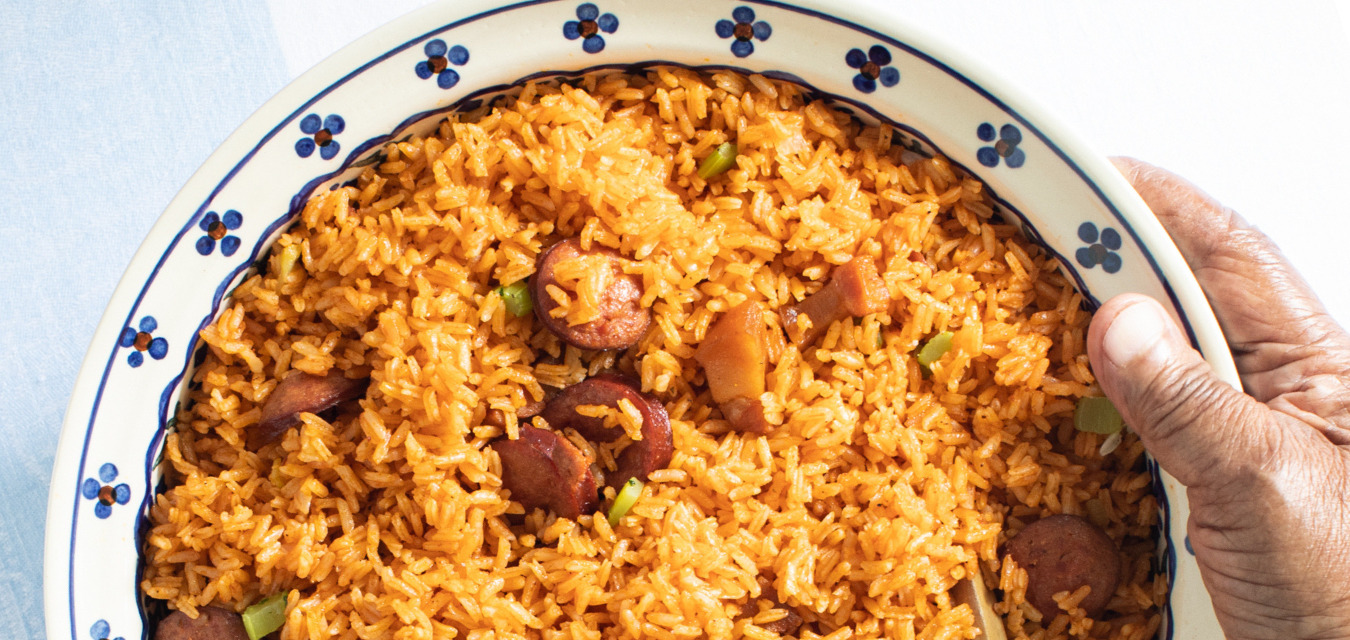“Red rice goes back to the old, old days—the days before me, my momma, and hers. Red rice is a beautiful, earthy one-pot rice dish that borrows from the traditions of my African ancestors. Sometimes called Charleston red rice, red rice really owes a great debt to the enslaved Africans who brought their knowledge of rice and vegetable farming to the United States.
Here on Edisto, Wednesdays and Fridays were seafood days. We had shrimp or fish with red rice, so it was something to look forward to. Back in my day, you didn’t use tomato paste and sauce, you used the tomatoes you’d planted in your garden. The tomato paste works just as good, though, and Gullah Geechee red rice is one of the best dishes you can enjoy. Now, red rice can be a tricky thing. If you don’t have enough rice, it will come out like mush. If you have too much rice, you can add water, but the texture will be uneven. Early in the cooking, you want to use your spoon to feel the weight of the rice, and make sure it’s cooking evenly.
Don’t let this dish intimidate you—with well-seasoned vegetables, slices of sausage, and perfectly cooked rice, you’ve just about got yourself a meal. Oh, and when you put some fatback in there? Now you’re talking.”
Excerpt from the new book Gullah Geechee Home Cooking: Recipes from The Matriarch of Edisto Island, by Emily Meggett, published by Abrams. Text © 2022 Emily Meggett. Photography by Clay Williams.
yields
Serves 8 to 10
½ pound salt pork, cut into 1-inch chunks
1 large onion, chopped
1 large bell pepper, chopped
½ cup chopped celery
3 smoked sausages (about 14 ounces)
1 (6-ounce) can tomato paste
1 teaspoon crushed red pepper
1½ teaspoons Nature’s Seasons, plus more to taste
2 cups long-grain white rice, unrinsed
ingredients
steps
- Fry the salt pork in a large pot over medium heat until browned, 8 to 10 minutes. Add the onion, bell pepper, and celery and cook until tender, 5 to 7 minutes. Cut the sausage into bite-size pieces and add to the pot; cook until lightly browned, about 5 minutes. Stir in the tomato paste and 5 cups water and bring to a boil over high heat. Add the crushed red pepper and Nature’s Seasons and stir. Taste and add more seasoning if needed.
- Add the rice. Cook, stirring frequently to keep the rice from sticking, until most of the liquid has been absorbed and the rice is tender, about 10 minutes.
- If using a rice steamer, transfer the absorbed mixture to the steamer. Cover the steamer, and cook on low heat for 15 to 20 minutes, or until all of the liquid is absorbed and the rice can be fluffed with a fork. If using a pot, cover the pot and cook over the lowest possible heat, stirring with a fork as needed, for 25 to 30 minutes, or until the rice has absorbed all the liquid.
shop products
share
-
Excerpt From
Gullah Geechee Home Cooking: Recipes from The Matriarch of Edisto Island, by Emily Meggett, published by Abrams. Text © 2022 Emily Meggett. Photography by Clay Williams.







